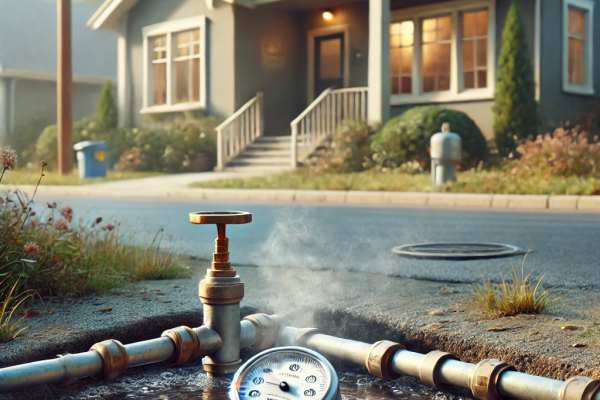
What Are the Warning Signs of a Gas Leak—and How Can You Prevent One?
Natural gas and propane are indispensable fuel sources for many households across the country. They power furnaces, water heaters, stoves, clothes dryers, and more. In regions like Texas, where both residential and commercial properties frequently rely on gas-powered systems, awareness of gas leak hazards is especially vital. A gas leak can result in severe consequences—fires, explosions, or carbon monoxide poisoning—if not quickly detected and addressed. This comprehensive guide will help you recognize the warning signs of a gas leak, take immediate steps to protect everyone in your home, and prevent leaks from occurring in the future.
Gas leaks often start subtly. A loose connection, corroded piping, or malfunctioning appliance might slowly release small amounts of gas, making detection challenging if you don’t know the signs. Over time, gas buildup can lead to health risks, structural damage, and even life-threatening emergencies. In Texas, the combination of high temperatures, humidity, and extreme weather events can put additional strain on gas lines, increasing the chances of damage and corrosion. By staying aware of warning signs and ensuring proper upkeep, you can greatly reduce the risk of a dangerous leak.
Why Gas Leak Awareness Is So Important
A gas leak doesn’t always announce itself with a strong odor. Sometimes, leaks remain hidden until the problem becomes severe. Most gas suppliers add a chemical called mercaptan to natural gas, giving it a sulfur-like or “rotten egg” smell. However, factors such as individual differences in sense of smell, strong ventilation, or loss of additive potency can make a leak less obvious. This is why it’s crucial to understand other signs, too, including unusual hissing noises or physical symptoms like headaches and fatigue.
A proactive approach is especially valuable in Texas. Rapid weather changes, from blistering summers to occasional freezing winters, can stress gas lines and appliances. Extremely high temperatures and storms may accelerate corrosion and cause undetected damage. Recognizing the first hint of trouble can prevent a minor leak from escalating into a serious emergency.
How to Recognize a Gas Leak
Most homeowners are familiar with the rotten egg odor associated with natural gas, but some leaks go unnoticed if the smell is dispersed or not easily detected. Here are additional signs:
1. Hissing or Whistling Noises
Gas leaks under pressure can produce a distinct hissing or whistling sound near pipelines, connectors, or gas-powered appliances. Even if the noise seems faint or could be tied to something else (like plumbing), it’s best to rule out a gas leak first.
2. Sulfur or Rotten Egg Smell
The sulfuric odor is one of the strongest indicators of a gas leak. If this smell persists in any area of your home, especially close to the stove or furnace, shut off the appliance if it’s safe, evacuate, and call your utility company right away.
3. White Clouds or Dust Near Gas Lines
Outdoors, watch for unexplained dust clouds or foggy plumes around buried or above-ground pipes. Indoors, you might see a light mist if gas is escaping near the leak source.
4. Bubbling in Water or Drains
Standing water or drain areas that produce random bubbles can indicate gas escaping beneath the surface. This situation sometimes occurs if underground pipes are damaged.
5. Visible Damage to a Gas Line
Corrosion, dents, or cracks on pipes and connectors are physical signs that a line may be failing. Texan homeowners, in particular, should stay mindful of how heat, storms, and shifting soil can damage outdoor gas lines.
6. Wilting or Dead House Plants
Gas can displace oxygen in soil, depriving roots of what they need to grow. If potted plants near gas lines or appliances suddenly wilt, consider testing for a leak.
7. Increased Gas Bill
A sharp, unexplained rise in your monthly bill could be more than just a seasonal usage change. If you haven’t significantly altered how you use gas—and especially if you’re using less—there may be a hidden leak driving up costs.
Physical Symptoms of a Gas Leak
Even if you overlook environmental clues, your body may alert you to a problem:
- Trouble Breathing or Chest Pain: Gas leaks displace oxygen, potentially causing shortness of breath.
- Dizziness, Lightheadedness, Headaches, or Fatigue: If multiple household members experience these symptoms simultaneously, especially in a specific area of the home, it’s a red flag.
- Flu-Like Symptoms: Nausea, fatigue, and general weakness without a fever might indicate gas exposure.
- Mood Changes or Changes in Appetite: Irritability, confusion, or a sudden lack of interest in food can be subtle warning signs.
- Paleness or Blistering on the Skin: Prolonged exposure to gas can irritate skin and cause unusual reactions.
- Frequent Nosebleeds: Some people are particularly sensitive to toxins in leaked gas.
Symptoms in Pets
Keep an eye on your pets. They might show warning signs first, including:
- Rapid or labored breathing
- Unusual lethargy or lack of coordination
- Appetite changes or disorientation
- Red, irritated eyes or skin
- Uncharacteristic vomiting
If you observe these issues in your animals, investigate a possible gas leak immediately.
How to Check for a Gas Leak in Your Home
1. Listen for Hissing or Whistling
Start by locating your gas lines (if you know where they’re installed). Even a low-level hiss can point to a moderate or severe leak.
2. Inspect Your Gas Appliances
Turn on a burner on your gas stove and look at the flame. A healthy flame is blue. If you notice an orange or red flame, shut it off, ventilate the area, and call your gas utility. This color shift can indicate incomplete combustion due to a leak or appliance malfunction.
3. Perform the Soapy Water Test
Combine a teaspoon of dish soap with a cup of water and apply the mixture around joints or fittings. If you see bubbling that continues to form, gas is likely escaping at that point.
4. Use a Gas Leak Detector
Available at many home improvement stores, these devices can be installed near furnaces, water heaters, or stoves to monitor gas levels. In an environment like Texas—with high usage and fast-changing weather—such detectors provide extra peace of mind.
5. Contact a Professional
If you remain unsure, call your gas utility company or a licensed contractor for an inspection. It’s far safer to have an expert verify there’s no leak than to hope for the best.
What to Do If You Suspect a Gas Leak
-
Evacuate Immediately
- Get everyone out of the building, including pets.
- Avoid flipping any switches or using electronics that could spark.
-
Call for Help
- Once safely outside, call your gas utility company.
- If you can’t reach them, dial 911 and report the situation.
-
Wait for Clearance
- Don’t re-enter the property until professionals declare it safe.
- Gas can accumulate quickly, and even minor sparks can ignite a fire or explosion.
-
Arrange for Repairs
- Once the leak is sealed, schedule a thorough inspection of all gas lines and appliances.
- Replace or repair any compromised parts to prevent future leaks.
Why Gas Leaks Are Especially Concerning in Texas
Texas is known for intense heat, sudden storms, and shifting weather patterns, all of which can increase wear on gas lines:
- Corrosion and Wear: Heat and humidity speed up metal pipe corrosion.
- Storm Damage: High winds, falling debris, or flooding can crack or displace outdoor pipes.
- Soil Shifting: Extended droughts followed by heavy rain can cause the ground to swell and shrink, putting stress on underground lines.
Year-round vigilance—especially before and after extreme weather events—can catch small problems before they escalate.
How to Prevent Gas Leaks
1. Schedule Routine Maintenance
Have a certified technician inspect your appliances and gas lines annually. This ensures any early signs of deterioration are caught and repaired.
2. Plan Regular Gas Line Inspections
Gas lines don’t last forever. Corrosion, physical damage, and age can create small leaks that worsen over time. A professional can spot issues invisible to an untrained eye.
3. Ensure Proper Ventilation
Gas appliances need adequate airflow to burn fuel safely. Keep vents clear of dust, debris, and blockages. In Texas’s humid climate, check often for mold or mildew buildup that might clog ventilation systems.
4. Clean and Test Appliances
Regularly clean your stove, furnace, and other gas-based devices. Clogged burners or vents can cause inefficient combustion, sometimes leading to leaks.
5. Know Your Gas Shut-Off Valve
Identify and clearly label your main shut-off valve. Make sure everyone in the household knows where it is and how to turn it off during emergencies.
6. Educate Everyone at Home
Teach family members (and frequent visitors) how gas smells, where detectors are located, and how to test for a suspected leak with soapy water. Familiarity can make all the difference when seconds matter.
Additional Safety Tips and Considerations
- Carbon Monoxide Detectors: Gas leaks sometimes go hand in hand with incomplete combustion, producing carbon monoxide (CO). Although a CO detector won’t catch a strictly gas-related leak, it will alert you if fuel-burning appliances aren’t venting properly.
- Outdoor Gas Line Awareness: Call 811 before digging. Utility companies will mark underground lines, preventing accidental damage.
- Consider Upgrading Older Appliances: Modern appliances often come with fail-safes, like automatic shut-off valves. They’re also more energy-efficient, potentially lowering utility costs.
- Post-Storm Inspections: After major storms or high winds, walk around your property to check for debris or damage that could compromise gas lines.
Staying Proactive: The Key to Gas Safety
Most gas leaks are preventable through ongoing maintenance, household education, and rapid action at the first sign of trouble. If you suspect a leak or see a sudden spike in your gas bill, don’t ignore it—evacuate, call your utility, and have a professional inspection. Quick responses can avert dangerous situations and protect your loved ones.
Texas homeowners should be especially mindful of how extreme weather affects their gas lines. Incorporate regular checks into your routine, especially following heatwaves, storms, or significant temperature swings. By combining awareness, proper upkeep, and professional assessments, you can enjoy the benefits of gas utilities while minimizing risks.
Conclusion
Recognizing the signs of a gas leak—be it an odd smell, hissing sound, unexplained physical symptoms, or rapidly dying houseplants—could save your home and your health. If you detect or suspect a leak, leave immediately and contact your gas utility company or emergency services.
Once the situation is under control, schedule a detailed inspection to pinpoint and resolve the cause. Proactive measures, such as installing gas detectors, performing soapy water tests, and ensuring everyone in the household is informed about potential risks, will significantly reduce the chances of experiencing a dangerous leak. In a climate as varied as Texas’s, these practices are essential for keeping your property secure and your family safe.






